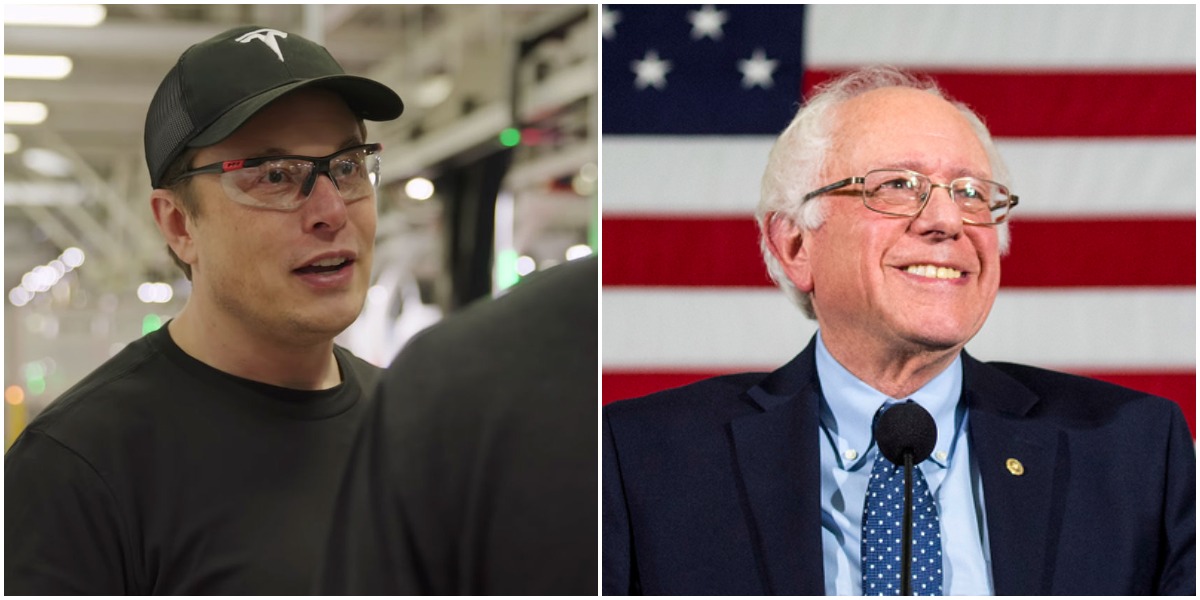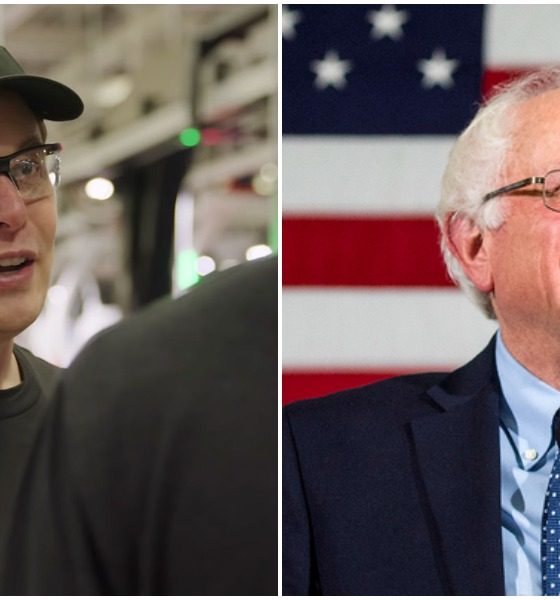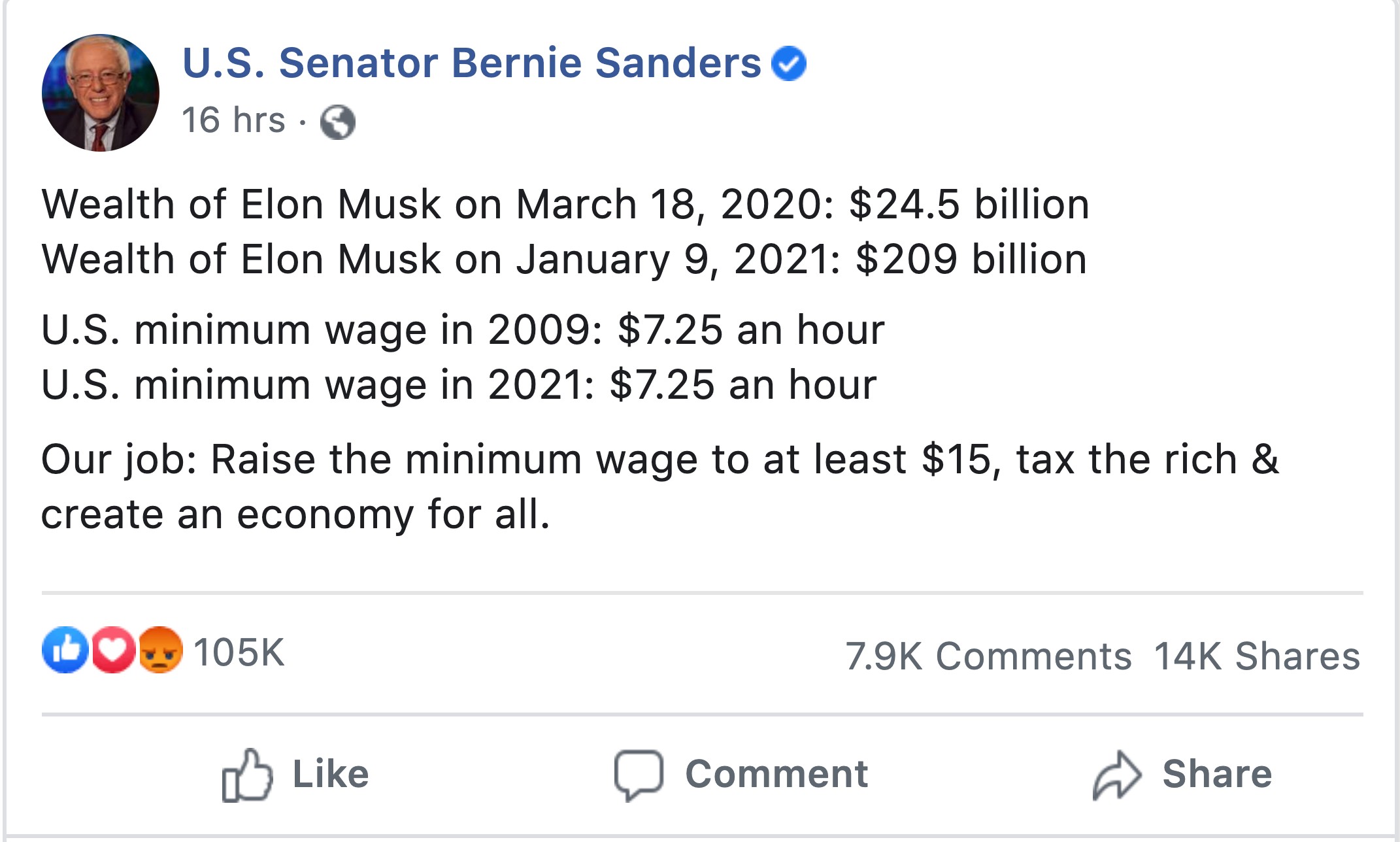

News
Elon Musk’s net worth attacked by VT Senator Bernie Sanders
Elon Musk is the richest man in the world with an estimated net worth of over $200 billion. Bernie Sanders, a long-time United States Senator from Vermont, isn’t too pleased about it.
Sanders, a Progressive Independent politician who has run for President on multiple occasions, has been vocal regarding the “issue” of billionaires and having the wealthy business people of the world pay their fair share. With Musk gaining a considerable amount of money in 2020 thanks to Tesla’s unbelievable stock run, he became the subject of a Bernie Sanders rant on Facebook, where the Senator highlighted the growth in the Tesla CEO’s net worth while the U.S. minimum wage has stayed the same.
“Wealth of Elon Musk on March 18, 2020: $24.5 billion
Wealth of Elon Musk on January 9, 2021: $209 billion,” the Senator wrote.
“U.S. minimum wage in 2009: $7.25 an hour
U.S. minimum wage in 2021: $7.25 an hour.
Our job: Raise the minimum wage to at least $15, tax the rich & create an economy for all.”

Musk’s net worth has been attacked by Sanders in the past. In August, Sanders proposed that Musk pay a one-time $27.5 billion tax, which would eliminate 60% of the Tesla CEO’s net worth gain during the COVID-19 pandemic. It was apart of Bernie’s “Americans for Tax Fairness and Institute for Policy,” and Musk wasn’t a fan of it.
— Elon Musk (@elonmusk) August 7, 2020
Musk, who gained the “World’s Richest Person” title last week, does not collect a salary from Tesla and his net worth comes from his 20.8% holding in the electric automaker, which makes him the majority shareholder. The company has gained over 700% in its valuation since last year, mostly because of increased sales figures and its ability to scale production while combating demand, which is as high as its ever been. While many CEOs with a massive net worth spend their dollars on big houses, fast cars, and ritzy vacations, Musk has spent the last year trying to figure out how to make EVs reach price parity with gas cars, while figuring out manufacturing bottlenecks and trying to build a new battery in-house, which will increase energy and range of Tesla’s cars.
In fact, the work rarely stops for Musk. After finding out that he was the world’s richest person, he was relatively unphased. “Back to work,” he said to @TeslaOwnersSV, who notified Musk of his new title.
ALSO READ:
Elon Musk donates to Barstool Fund in support of small business relief fund
Musk also doesn’t own any houses in his company’s home state of California. He sold them all after stating that his possessions weigh him down and his full focus would be turned toward getting humans to Mars.
Despite Musk’s desire to combat climate issues and cut dependence on fossil fuels, he is still the subject of attack from American socialists who are looking for economic equality for all Americans. The question is, where does that money come from? Sanders believes the rich should pay their fair share. But Musk’s net worth is tied up in his massive holdings of TSLA stock, which would force him to dilute his shares and would likely cost him his title as majority stakeholder.
Sanders’ plan to increase the minimum wage has arguments both ways. However, Musk has been a repeated target of Bernie’s because of his net worth. This is just the most recent example.
What do you think? Leave a comment down below. Got a tip? Email us at tips@teslarati.com or reach out to me at joey@teslarati.com.

Elon Musk
Elon Musk and Tesla AI Director share insights after empty driver seat Robotaxi rides
The executives’ unoccupied tests hint at the rapid progress of Tesla’s unsupervised Robotaxi efforts.

Tesla CEO Elon Musk and AI Director Ashok Elluswamy celebrated Christmas Eve by sharing personal experiences with Robotaxi vehicles that had no safety monitor or occupant in the driver’s seat. Musk described the system’s “perfect driving” around Austin, while Elluswamy posted video from the back seat, calling it “an amazing experience.”
The executives’ unoccupied tests hint at the rapid progress of Tesla’s unsupervised Robotaxi efforts.
Elon and Ashok’s firsthand Robotaxi insights
Prior to Musk and the Tesla AI Director’s posts, sightings of unmanned Teslas navigating public roads were widely shared on social media. One such vehicle was spotted in Austin, Texas, which Elon Musk acknowleged by stating that “Testing is underway with no occupants in the car.”
Based on his Christmas Eve post, Musk seemed to have tested an unmanned Tesla himself. “A Tesla with no safety monitor in the car and me sitting in the passenger seat took me all around Austin on Sunday with perfect driving,” Musk wrote in his post.
Elluswamy responded with a 2-minute video showing himself in the rear of an unmanned Tesla. The video featured the vehicle’s empty front seats, as well as its smooth handling through real-world traffic. He captioned his video with the words, “It’s an amazing experience!”
Towards Unsupervised operations
During an xAI Hackathon earlier this month, Elon Musk mentioned that Tesla owed be removing Safety Monitors from its Robotaxis in Austin in just three weeks. “Unsupervised is pretty much solved at this point. So there will be Tesla Robotaxis operating in Austin with no one in them. Not even anyone in the passenger seat in about three weeks,” he said. Musk echoed similar estimates at the 2025 Annual Shareholder Meeting and the Q3 2025 earnings call.
Considering the insights that were posted Musk and Elluswamy, it does appear that Tesla is working hard towards operating its Robotaxis with no safety monitors. This is quite impressive considering that the service was launched just earlier this year.
Elon Musk
Starlink passes 9 million active customers just weeks after hitting 8 million
The milestone highlights the accelerating growth of Starlink, which has now been adding over 20,000 new users per day.

SpaceX’s Starlink satellite internet service has continued its rapid global expansion, surpassing 9 million active customers just weeks after crossing the 8 million mark.
The milestone highlights the accelerating growth of Starlink, which has now been adding over 20,000 new users per day.
9 million customers
In a post on X, SpaceX stated that Starlink now serves over 9 million active users across 155 countries, territories, and markets. The company reached 8 million customers in early November, meaning it added roughly 1 million subscribers in under seven weeks, or about 21,275 new users on average per day.
“Starlink is connecting more than 9M active customers with high-speed internet across 155 countries, territories, and many other markets,” Starlink wrote in a post on its official X account. SpaceX President Gwynne Shotwell also celebrated the milestone on X. “A huge thank you to all of our customers and congrats to the Starlink team for such an incredible product,” she wrote.
That growth rate reflects both rising demand for broadband in underserved regions and Starlink’s expanding satellite constellation, which now includes more than 9,000 low-Earth-orbit satellites designed to deliver high-speed, low-latency internet worldwide.
Starlink’s momentum
Starlink’s momentum has been building up. SpaceX reported 4.6 million Starlink customers in December 2024, followed by 7 million by August 2025, and 8 million customers in November. Independent data also suggests Starlink usage is rising sharply, with Cloudflare reporting that global web traffic from Starlink users more than doubled in 2025, as noted in an Insider report.
Starlink’s momentum is increasingly tied to SpaceX’s broader financial outlook. Elon Musk has said the satellite network is “by far” the company’s largest revenue driver, and reports suggest SpaceX may be positioning itself for an initial public offering as soon as next year, with valuations estimated as high as $1.5 trillion. Musk has also suggested in the past that Starlink could have its own IPO in the future.
News
NVIDIA Director of Robotics: Tesla FSD v14 is the first AI to pass the “Physical Turing Test”
After testing FSD v14, Fan stated that his experience with FSD felt magical at first, but it soon started to feel like a routine.

NVIDIA Director of Robotics Jim Fan has praised Tesla’s Full Self-Driving (Supervised) v14 as the first AI to pass what he described as a “Physical Turing Test.”
After testing FSD v14, Fan stated that his experience with FSD felt magical at first, but it soon started to feel like a routine. And just like smartphones today, removing it now would “actively hurt.”
Jim Fan’s hands-on FSD v14 impressions
Fan, a leading researcher in embodied AI who is currently solving Physical AI at NVIDIA and spearheading the company’s Project GR00T initiative, noted that he actually was late to the Tesla game. He was, however, one of the first to try out FSD v14.
“I was very late to own a Tesla but among the earliest to try out FSD v14. It’s perhaps the first time I experience an AI that passes the Physical Turing Test: after a long day at work, you press a button, lay back, and couldn’t tell if a neural net or a human drove you home,” Fan wrote in a post on X.
Fan added: “Despite knowing exactly how robot learning works, I still find it magical watching the steering wheel turn by itself. First it feels surreal, next it becomes routine. Then, like the smartphone, taking it away actively hurts. This is how humanity gets rewired and glued to god-like technologies.”
The Physical Turing Test
The original Turing Test was conceived by Alan Turing in 1950, and it was aimed at determining if a machine could exhibit behavior that is equivalent to or indistinguishable from a human. By focusing on text-based conversations, the original Turing Test set a high bar for natural language processing and machine learning.
This test has been passed by today’s large language models. However, the capability to converse in a humanlike manner is a completely different challenge from performing real-world problem-solving or physical interactions. Thus, Fan introduced the Physical Turing Test, which challenges AI systems to demonstrate intelligence through physical actions.
Based on Fan’s comments, Tesla has demonstrated these intelligent physical actions with FSD v14. Elon Musk agreed with the NVIDIA executive, stating in a post on X that with FSD v14, “you can sense the sentience maturing.” Musk also praised Tesla AI, calling it the best “real-world AI” today.








